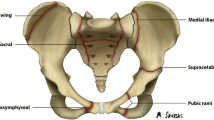Abstract
High-risk stress fractures require precise assessment and treatment because of their propensity for delayed union, nonunion, or complete fracture and their resulting disabling complications. Proper diagnosis necessitates a thorough clinical evaluation, centering on the patient's diet and history, particularly the training regimen. For a definitive diagnosis, plain radiography, ultrasound, bone scintigraphy, magnetic resonance imagery (MRI), and computed tomography (CT) are helpful, and each plays a specific role. High-risk stress fractures typically require aggressive treatment such as nonweight-bearing immobilization coupled with therapy and often surgery.
Similar content being viewed by others
References
Breithaupt MD. The pathology of the human foot [in German]. Medizin Zeitung 1855;24:169–175.
Devas MB. Stress fracture of the tibia in athletes or “shin soreness”. J Bone Joint Surg Am 1958;40B:227–236.
McBryde AM. Stress fractures in athletes. J Sports Med 1975;3:212–217.
Boden BP, Osbahr DC. High-risk stress fractures: evaluation and treatment. J Am Acad Orthop Surg 2000;8(6):344–353.
Rockwood CA, Green DP. Fractures in adults. J.B. Lippincott, Philadelphia, 1991, pp. 1–8.
Reeder MT, Dick BH, Atkins JK, et al. Stress fractures: current concepts of diagnosis and treatment. Sports Med 1996;22(3):198–212.
Tuan K, Wu S, Sennett B. Stress fractures in athletes: risk factors, diagnosis, and management. Orthopedics 2004;27(6):583–591.
Greaney RB, Gerber FH, Laughlin RL, et al. Distribution and natural history of stress fractures in US Marine recruits. Radiology 1983; 146:339–346.
Frederichson M, Bergman AG, Hoffman KL, et al. Tibial stress reaction in nunners: correlation of clinical symptoms and scintography with a new MRI grading system. Am J Sports Med 1995;23(4):472–481.
Stanitski CL, McMaster JH, Scranton PE. On the nature of stress fractures. Am J Sports Med 1978;6(6):391–396.
Sullivan D, Warren RF, Pavlov H, et al. Stress fractures in 51 runners. Clin Orthop 1984;187:188–192.
Friberg O. Leg length asymmetry in stress fractures. A clinical and radiological study. J Sports Med Phys Fitness 1982;22:485–488.
Murray SR, Reeder M, Ward T, et al. Navicular stress fractures in identical twin runners: high-risk fractures require structured treatment. Phys Sportsmed 2005;33(1):28–33.
Matheson GO, Clement DB, McKenzie DC, et al. Stress fractures in athletes: a study of 320 cases. Am J Spors Med 1987;15(1):46–58.
Pester S, Smith PC. Stress fractures in the lower extremities of soldiers in basic training. Orthop Rev 1992;21(3):297–303.
Protzman RR, Griffis CG. Stress fractures in men and women under-going military training. J Bone Joint Surg Am 1977;59:825.
Hulkko A, Orava S. Stress fractures in athletes. Int J Sports Med 1987;8(3):221–226.
Myburgh KH, Hutchins J, Fataar AB, et al. Low bone density is an etiologic factor for stress fracture sin athletes. Ann Intern Med. 1990;113:754–759.
Bennell KL, Malcolm SA, Thomas SA, et al. The incidence and distribution of stress fractures in competitive track and field athletes: A twelve-month prospective study. Am J Sports Med 1996;24:211–217.
Marcus R, Cann C, Madvig P, et al. Menstrual function and bone mass in elite women distance runners: endocrine and metabolic features. Ann Intern Med 1985;102(2):158–163.
Peter S, Smith PC. Stress fractures in the lower extremities of soldiers in basic training. Orthop Rev 1992;21(3):297–303.
Boden BP, Osbahr DC, Jimenez C. Low-risk stress fractures. Am J Sports Med 2001;29(1):100–111.
Noakes, TD. Lore of Running: Discover the Science and Spirit of Running. Leisure Press, Champaine, IL, 1991.
Kaeding CC, Spindler KP, Amendola A. Management of troublesome stress fractures. Instr Course Lect 2004;53:455–469.
Saxena A, Fullem B, Hannaford D. Results of treatment of 22 navicular stress fractures and a new proposed radiographic classification system. J Foot Ankle Surg 2000;39(2):96–103.
Myburge KH, Hutchins J, Fataar AB, et al. Low bone density is an etiologic factor for stress fractures in athletes. Ann Intern Med 1990; 113:754–759.
Barrow, GW, Saha S. Menstrual irregularity and stress fractures in collegiate female distance runners. Am J Sports Med 1988;16:209–216.
Bruckner P, Bradshaw C, Bennell K. Managing common stress fractures: let risk level guide treatment. Phys Sportsmed 1998;26(8):39–47.
Author information
Authors and Affiliations
Corresponding author
Additional information
The authors have stated that they do not have a significant financial interest or other relationship with any product manufacuturer or provider of services discussed in this article. The authors do not discuss the use of off-label products, which includes unlabeled, unapproved, or investigative products or devices.
About this article
Cite this article
Murray, S.R., Reeder, M.T., Udermann, B.E. et al. High-risk stress fractures. Compr Ther 32, 20–25 (2006). https://doi.org/10.1385/COMP:32:1:20
Received:
Accepted:
Issue Date:
DOI: https://doi.org/10.1385/COMP:32:1:20




